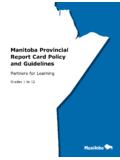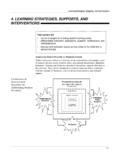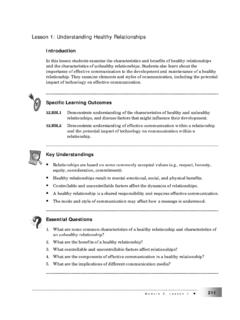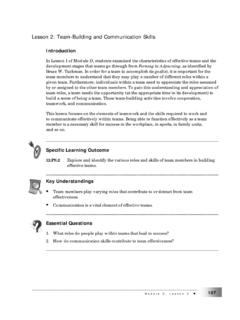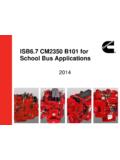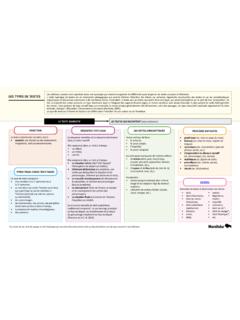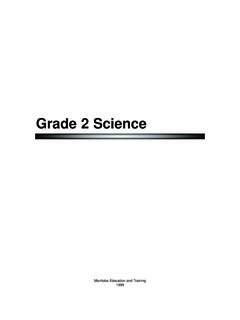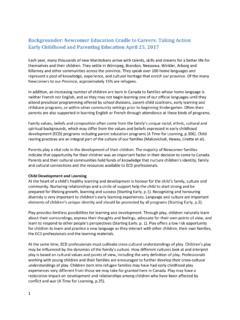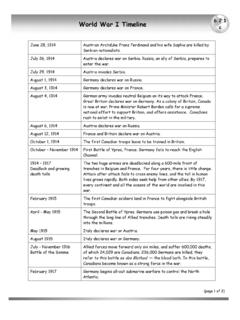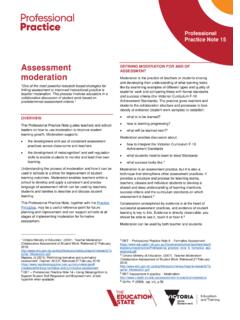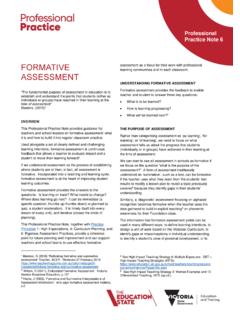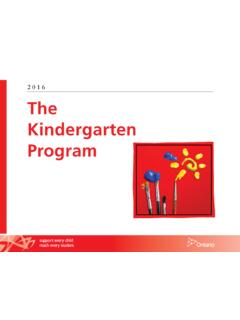Transcription of Manitoba Provincial Report Card Policy and Guidelines
1 Manitoba Provincial Report card Policy and Guidelines Partners for Learning Grades 1 to 12 2017 Manitoba Education and Training Ma n i t o b a Pr o v i n c i a l re P o r t ca r d Po l i c y a n d Gu i d e l i n e sPartners for Learning Grades 1 to 12 Manitoba Education and Training Cataloguing in Publication Data Manitoba Provincial Report card Policy and Guidelines [electronic resource] : partners for learning, Grades 1 to 12 Includes bibliographical references. ISBN: 978- 0 -7711-7611-1 1. Grading and marking (Students) Manitoba . 2. Report cards Government Policy Manitoba . 3. Students Evaluation Manitoba . 4. Students Rating of Manitoba . I. Manitoba . Manitoba Education and Training. Copyright 2017, the Government of Manitoba , represented by the Minister of Education and Training.
2 Manitoba Education and Training Winnipeg, Manitoba , Canada Every effort has been made to acknowledge original sources and to comply with copyright law. If cases are identified where this has not been done, please notify Manitoba Education and Training. Errors or omissions will be corrected in a future edition. Sincere thanks to the authors, artists, and publishers who allowed their original material to be used. All images found in this document are copyright protected and should not be extracted, accessed, or reproduced for any purpose other than for their intended educational use in this document. Any websites referenced in this document are subject to change. Educators are advised to preview and evaluate websites and online resources before recommending them for student use.
3 Print copies of this document (stock number 80696) can be purchased from the Manitoba Learning Resource Centre. Order online at This document is available on the Manitoba Education and Training website at This document was revised in 2017. Disponible en fran ais. Available in alternate formats upon request. Contentsvco n t e n t s1. Introduction 1 Reporting Purposes 3 Foundational Principles for Grading 5 2. Preparation and Distribution 7 Report card Format Requirements 9 Delivery and Return 9 Reporting Frequency, Responsibility, and Content 9 3. Separately Reporting Academic Achievement and Learning Behaviours 11 4. Report card Sections 15 Attendance 17 Student Programming 17 Student Programming Grades 1 to 8 17 Student Programming Grades 9 to 12 21 Academic Achievement 22 Academic Achievement Scales Ordinal and Percentage 22 NA Not Applicable.
4 And IN Incomplete 24 Provincial Tests and Other Final Exams 26 Assigning Grades 26 Subject Grading Boxes Grades 1 to 8 28 Subject Categories 28 Reporting on Arts Education 29 Optional Subjects 30 School-Based Learning Experiences 30 Multi-Subject Grading Box 31 Learning Behaviours 32 Behavioural Scale and Categories 32 Teacher Comments 35 Next School Year Grades 1 to 8 36 Graduation Chart Grades 9 to 12 37 Manitoba Provincial Report card Policy and Guidelines : Partners for Learningvi5.
5 Local Options for Reporting 39 Appendix 43 Frequently Asked Questions 45 Planning for Reporting 49 Planning for EAL and Subject Learning Grades 1 to 8 50 Planning for Litt ratie fran aise (L) and Subject Learning Grades 9 to 12 50 Manitoba High School Statement of Marks 51 Subject Categories and Descriptions Grades 1 to 8 52 English Language Arts 52 Fran ais Fran ais Program 53 Fran ais French Immersion Program 54 Mathematics 55 Science 56 Social Studies 57 Physical Education and Health Education 58 Music 59 Dance 60 Drama 61 Visual Arts 62 French English Program 63 Bibliography 65 Ma n i t o b a Pr o v i n c i a l re P o r t ca r d Po l i c y a n d Gu i d e l i n e s 1. Introduction Reporting Purposes 3 Foundational Principles for Grading 5 Introduction31.
6 In t r o d u c t i o nManitoba Education and Training has introduced a Provincial Report card mandated for public school division use beginning in the 2013/2014 school The Report card has been developed based on feedback from a field trial and through extensive consultations, in order to meet the goal of providing clear, consistent information for parents based on a coherent framework for assessment , grading, and reporting. The Report card and the supporting framework on which it is based will help to enhance the quality of education in Manitoba and to build strong partnerships amongst students, teachers, and parents. This document provides Guidelines and policies primarily for educators, but also for others, with respect to its use.
7 It may also be of interest to parents. Further information as well as the Report card templates (not for direct use but rather to illustrate the format and content) are available at w w w. e du .g o Policy statements in this document are clearly indicated. Divisions must obtain written approval from Manitoba Education and Training for any deviation from these policies. School divisions and student information system (SIS) vendors have been provided with a document outlining business rules for the templates in order to guide the work of configuring SISs. Reporting Purposes The primary purpose of the Manitoba Report card is to formally communicate to parents, at certain points in time, information on their children s growth and achievement as learners.
8 Based on a vision of success for each child s unique academic, intellectual, social, emotional, and physical development, the Report card details learning strengths and potential challenges, as well as what next steps might help improve the learning. Furthermore, students can, through the Report card , gauge their accomplishments as they develop important knowledge, skills, and behaviours as lifelong learners and citizens. Manitoba s Vision: that every learner will complete a high school education with a profound sense of accomplishment, hope, and with the learner at the centre of the Manitoba s educational vision and mission, the Report card highlights each student s accomplishments as a knowledgeable and skilled academic critical thinker, active learner, socially responsible citizen, and personally responsible individual.
9 _____1. Schools outside of public school divisions, such as Independent or First Nations Schools may use or adapt the Provincial template, and may only present it as the Provincial Report card if all specifications, policies, and Guidelines are followed. 2. Manitoba Education and Training. Policy Manitoba Provincial Report card Policy and Guidelines : Partners for Learning4 This document is intended to help educators connect the Report card to curricula-based achievement, and to use the Provincial Report card to clearly communicate to parents and students regarding each student s learning. Enhanced communications and collaborative efforts will help to ensure that all Manitoba s children and youth have access to an array of educational opportunities such that every learner experiences success through relevant, engaging, and high quality education that prepares them for lifelong learning and citizenship in a democratic, socially just, and sustainable society.
10 3 The Provincial Report card forms one part of an important communication system. It formally documents and communicates a student s summative achievement to parents. No other kind of Report card that attempts to accomplish a similar task may be used. Specific details about what students are learning or how they are demonstrating the learning are best communicated using methods or tools other than the Report card . These may include monthly newsletters that refer to content being addressed in class, parent-teacher interviews, parent-teacher-student conferences, portfolios, web pages, and/or parent portals to elaborate on grades and other class or school matters. The benefits of the Provincial Report card include an extended ability to promote primarily, reporting of student achievement in a way that is clear and coherent for parents, students, and teachers positive school-parent relationships improved learning consistency across the province A clear, consistent approach to reporting on student achievement will bring additional clarity and coherence to how educators and parents discuss and understand student achievement.
